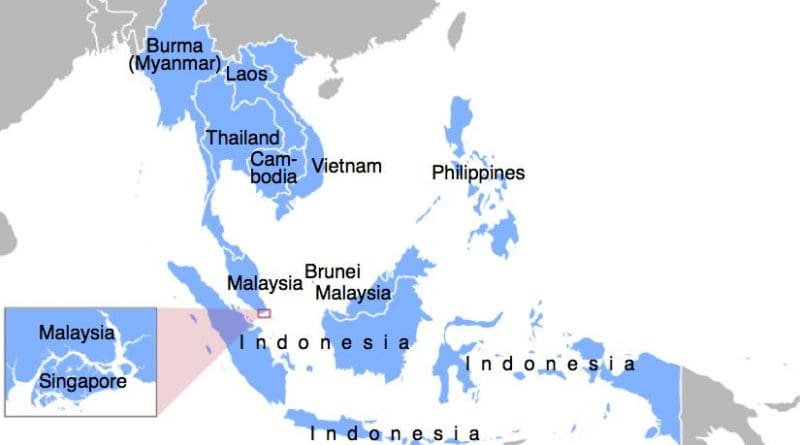Modi Visit Gives India Higher Profile In ASEAN – Analysis
By Mahendra Ved*
A new and powerful economic community is emerging in India’s extended neighborhood at a time when the world as a whole is facing economic uncertainties, combating the scourge of terrorism and is struggling to bridge differences in its response to counter the havoc being played by climate change.
All these issues dominated the twin gatherings, the ASEAN and East Asia Summit. They demand that India not just guard their interests, but also play the role befitting a large political entity that it is both regionally and globally.
Combining perceptions with rhetoric and lucrative calls to investors, Prime Minister Narendra Modi who attended the two summits and visited Singapore thereafter can be said to have dealt with more challenges facing India during this Southeast Asian sojourn than any of his foreign visits since he took office.
Having dithered when invited at its launch, India has been keen to make up the lost time and opportunity and integrate its economic endeavors with ASEAN. The 10-nation grouping is Asia’s most powerful. With 630 million people and USD 2.4 trillion GDP, it is certainly giving the European Union (EU) and North America a run for their money.
That, along with other regional trade pacts and the Trans-Pacific Partnership (TPP) that is gathering support among ASEAN member-nations, including India’s key partners like Singapore and Vietnam, require that India take a stand and follow it up with concrete measures, or else it risks being isolated. India may suffer on issues like Intellectual property rights but stands to gain from a grouping that is designed to contain China. US President Barack Obama, who was at the East Asia Summit, warned that those who don’t join would stand to lose.
Modi succinctly underscored the links between India and the ASEAN by saying that the latter has done its bit for Asia’s resurgence and it’s now India’s turn. He needs to initiate concrete measures by his government to make the “Look East” really “Act East” and ensure that it does not remain a mere slogan or a matter of intent.
He invited Malaysia and Singapore, with whom strategic partnerships have been forged, to invest in a myriad projects – IT, energy, affordable housing, roadways and railways among them. But he has to work to make India’s economy compatible to receive and absorb those investments, and not leave them as matters of mutual intent.
India needs to push a review of the free trade agreement (FTA) with ASEAN, getting the latter to shed the reservations about allowing Indian services in and work out similar pacts with individual ASEAN members if it really wants to boost trade with the region.
Modi projected India’s template of good governance and economic resurgence. But measures like the General Sales Tax (GST) law that would help lower tariffs, making Indian goods competitive in Southeast Asian market and required institutional reforms, have been lagging. They are likely to face greater political logjam, at least in the near future, slackening his “‘Act East” resolve.
With huge ethnic Chinese population and as ASEAN biggest trading partner, China, having deep pockets, enjoys huge advantage over anybody in that region. Yet, to the extent to which India integrates with ASEAN, besides yielding hefty economic advantages, could bolster the latter’s position vis-à-vis China on the territorial dispute in South China Sea. Modi did not name China, but stressed on freedom of navigation and support the UN Convention on the Law of the Sea. The message has been clearly sent.
Modi’s penchant to reach out to the Indian diaspora is well-known. But he did not quite re-enact Madison Square, Dubai or Wembley in either Malaysia or Singapore, keeping in mind the sensitivities of his hosts.
He pointedly talked to “Malay Indians”, although calling them “Malaysian Indians” would have been better, since Malays are the majority ethnic group. Both his interactions acted to reiterate, wittingly or otherwise, the Nehruvian view that has determined India’s approach to its 30 million diaspora worldwide, that they may retain their ancestral and cultural roots, but live as good citizens in their adopted homes.
The opening of Torana, the ceremonial gate with Hindu and Buddhist motifs, and the promise to help set up a memorial to the Indians who laid down their lives during the World War II in erstwhile Malaya; and setting up a memorial to the Indian National Army in Singapore should give both India and the ethnic Indian population in these countries a higher profile.
Muslim nations in Southeast Asia pride in practicing what they call “moderate Islam” and reject the Wahabist School that has spawned Salfists and extremist groups in their region. Modi echoed the Southeast Asian viewpoint on terrorism when he called for choking of funds to them and said that terrorism respected no faith, while misusing its label and knew no territorial boundaries. This would go down well with the general world view as well.
*Mahendra Ved is a Delhi-based columnist and strategic analyst. He can be reached at: [email protected]

